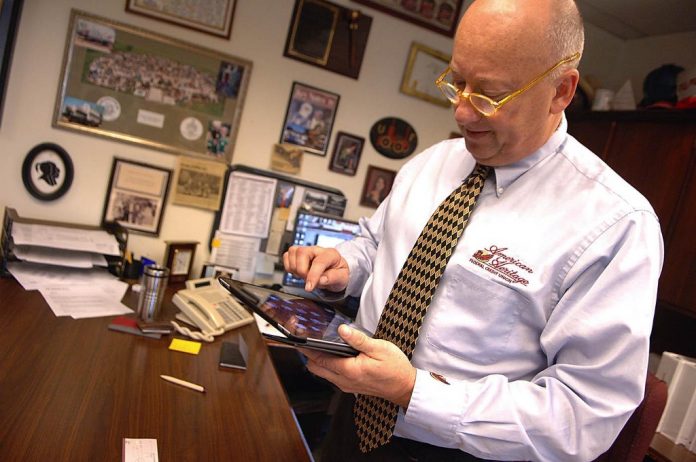Bruce Foulke is president and CEO of the American Heritage Federal Credit Union. JENNY SWIGODA / TIMES PHOTO
For the American Heritage Federal Credit Union, “going green” means a steady rise in customers and monetary deposits.
The building addition at the American Heritage Federal Credit Union on Red Lion Road is a physical representation of growth.
American Heritage is growing — a lot, said Mick Hilling, vice president for marketing, and the 24,000 square feet added to the credit union’s Carriage House branch is needed to accommodate that growth.
The addition also has a 2,117-square-foot, dividable meeting room. The Greater Bustleton Civic League, for example, expects to have its January meeting in that new room.
In the past three decades, American Heritage has swelled from four employees and 4,000 members to 312 employees and more than 100,000 members. It has 23 branches, the newest of which, a 4,800-square-foot building, recently opened at Harbison Avenue and Bridge Street. American Heritage is now the sixth-largest credit union in Pennsylvania.
The credit union is adding 60 new members a day, Hilling said. On Nov. 4, more than 90 signed up.
That extra boost came as part of a Facebook push to get depositors to move their money from the large “too big to fail” financial institutions to smaller banks and credit unions. Those new American Heritage members joined right before Bank Transfer Day, a national consumer-activism initiative on Nov. 5.
The concept was started by Kristen Christian, a California woman annoyed by debit-card fees imposed by her bank, said Patrick Keefe, vice president for communications and community outreach of the Credit Union National Association.
She got on Facebook and encouraged her friends to take their money out of banks and move them to credit unions, he said. About 500 said they would, Keefe added.
To say her suggestion blossomed might be a gross understatement.
In 2010, which Keefe called a flat year for growth, about 600,000 members joined the nation’s credit unions. In October alone, he said, credit unions got 650,000 members. On Nov. 5, he said, credit unions nationwide got 40,000 new members.
The attraction for consumers, said American Heritage’s president and CEO Bruce Foulke, is that the credit union is not a bank. Refer to American Heritage as a bank and Foulke immediately will say it isn’t.
“Credit union, not bank. Bank is a four-letter word,” Foulke said during an interview last week at his office on Red Lion Road.
Foulke can talk about the credit union’s interest and lending rates, personal attention and free services, but the biggest difference between a credit union and a commercial bank, he said, is that a credit union doesn’t exist to make a profit and a commercial bank has stockholders and high-priced executives to pay.
“Credit unions are member-owned, not-for-profit financial cooperatives,” he said.
They don’t sell stock. Any profit credit unions make goes back to member services; commercial-bank profits go to shareholders, he said.
People often believe they must work in a certain profession or for a specific company to join a credit union. Nationwide, that’s true for about two-thirds of the credit unions, Keefe said. Credit unions have eligibility requirements, but about a third have community charters.
For example, to join American Heritage, said Hilling and Foulke, a new member just has to live or work in the city. If that requirement isn’t met, membership eligibility can be achieved by paying $15 to join the credit union’s foundation.
Foulke said another attraction is that American Heritage doesn’t nickel-and-dime its members with a lot of fees. ATM use is free, and members have access to about 30,000 ATMs across the country.
There’s even a smart-phone app that will tell you where the nearest ATM is, Hilling said. In a few months, any device that includes a camera will be able to be used to make remote check deposits, Foulke said.
He picked up an iPad, signed onto the American Heritage Web site, and held his iPad over a check, clicked, and following prompts, he turned the check over and clicked on the endorsed side. The bank’s computer will scan the check to make sure it’s real. If all that is successful, the deposit will be made. The program won’t let you deposit the same check again.
This is just an example of how technology is making life easier for the credit union’s members.
Another feature, Foulke said, is American Heritage’s Personal Automated Teller, or PAT, which is an interactive machine that puts a customer in touch with “a real live teller” who can accept deposits, give money like an ATM, and answer questions. PATs include cameras, which will add security when they’re placed outdoors, he said.
Hilling said members who were surveyed have a 97 percent positive assessment of American Heritage. About 9,000 surveys, several pages long, were sent out, he said, and 1,700 came back.
Foulke likes to think that service is the credit union’s biggest selling point.
“The service level is totally different,” Foulke said. “People get to know you as a member. You can e-mail the CEO, and I answer.” ••
Reporter John Loftus can be reached at 215–354–3110 or [email protected]
Not a bank . . .
American Heritage Federal Credit Union was founded in 1948 for employees of the Budd Manufacturing Co. The name was changed to American Heritage in 1985.
Address: 2060 Red Lion Road
Phone: 1–800–342–0008
Web site: www.amhfcu.org
Branches: 23
Members: More than 100,000
Special event: There will be 3,000 seats available for the credit union’s Grand Illumination of a large Christmas tree, 7 to 8 p.m. on Saturday, Nov. 26.
The celebration will feature a fireworks display, Philadelphia Boys Choir, and Fifes and Drums of the Old Barracks. Meet Ben Franklin and friends, too.
Rain Date: Saturday, Dec. 3





